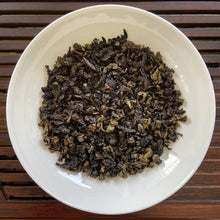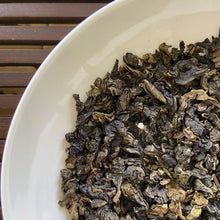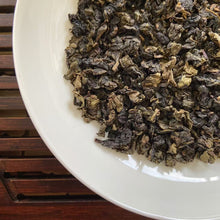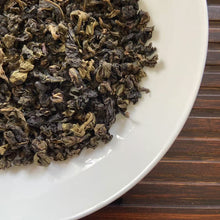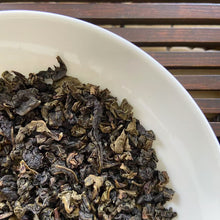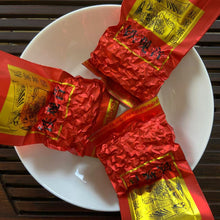
This Tie Guan Yin has been aged for 2 years till 2024 year and expertly charcoal roasted to enhance its depth of flavor. Each portion is vacuum-packed into convenient 7-gram mini bags, preserving the tea’s freshness and rich character.
Appearance:
The tea leaves are tightly curled with a darker, roasted appearance, a result of the traditional charcoal roasting process.
Liquor:
The tea liquor is clear with a warm, brownish hue, indicating a well-balanced roasting level.
Aroma and Taste:
The tea delivers a smooth and mellow flavor, complemented by a subtle sweetness. The roasted notes bring a sense of warmth, while the thick and rich texture provides a soothing and satisfying tea experience with each sip.
Brewing Recommendations:
For the best results, brew this Tie Guan Yin with water at 95°C–100°C (203°F–212°F). Use one 7-gram packet per 150ml of water. Steep for 10–20 seconds for the first infusion, and gradually increase the time for subsequent brews. This tea can be steeped multiple times, with each infusion revealing deeper layers of its roasted character.
Storage:
Store the tea in a cool, dry place, away from moisture and strong odors. If possible, avoid prolonged exposure to air to maintain the tea’s freshness and roasted flavor.
______________________________________
A more comprehensive introduction to Tie Guan Yin.
The authentic origin of Tie Guan Yin is Anxi County in Fujian Province, where it is harvested during four seasons: spring tea, summer tea, autumn tea, and winter tea. Among these, the teas harvested in spring and autumn are of the highest quality. The fragrance of Tie Guan Yin is often referred to as having an orchid aroma.
Tie Guan Yin can be classified into three main flavor profiles:
1. Lightly Fragrant Tie Guan Yin (also known as “Qingxiang” Tie Guan Yin), called “Qingcha” in Anxi.
2. Richly Fragrant Tie Guan Yin (also known as roasted Tie Guan Yin or “Tanbei” Tie Guan Yin), called “Shuhuocha” in Anxi.
3. Aged Tie Guan Yin ("Tie Guan Yin Lao Cha" or simply "Lao Tie"), which has been aged over time.
In the market, the lightly fragrant Tie Guan Yin accounts for 90% of the total circulation. This is mainly because within this category, there are four sub-flavors, each offering a unique sensory and taste experience.
Let’s break down the four subcategories of lightly fragrant Tie Guan Yin:
1. Lightly Fragrant Tie Guan Yin
If you believe that “lightly fragrant” simply refers to the light fragrance, you’re only partially correct. This category is named for its processing method, not just its fragrance. For instance, “Xiaoqing” and “Tuosuan” processes produce teas with very strong aromas. So, it’s important to remember that lightly fragrant Tie Guan Yin refers to the “Qingcha” (light tea) processing method in Anxi.
Due to differences in the fermentation process, this category can be further divided into the following subcategories:
1. Zhengwei
2. Xiaozheng
3. Xiaoqing
4. Tuosuan
These four types are primarily distinguished by their degree of fermentation:
• Zhengwei > Xiaozheng > Xiaoqing > Tuosuan.
Each has its own distinct aroma and taste, which we will now explain in more detail:
1. Zhengwei Tie Guan Yin
Zhengwei has the highest level of fermentation among the four, resulting in a strong aftertaste and durability over multiple brews. It is most suitable for tea drinkers with sensitive stomachs. This method closely resembles the traditional processing technique, where the tea is picked in the morning and roasted the next day.
• Characteristics:
The dry leaves are dark black or yellow-green. The tea soup has a clear fragrance, and the taste is gentle, sweet, and smooth. The aroma spreads from the throat, leaving a lasting sweetness and producing salivation. The tea soup is mild and fragrant, but if you find it too light, it may not suit your taste.
2. Xiaoqing Tie Guan Yin
Xiaoqing refers to a modern processing method where air conditioning is used to cool the leaves and create an ideal environment for oxidation. Fermentation is relatively light.
• Characteristics:
The dry leaves are bright green or dark green and visually appealing. The dry tea has a strong aroma, the tea soup is full-bodied, and the taste is sweeter and more intense than Zhengwei. Many newcomers to Tie Guan Yin enjoy Xiaoqing for its rich aroma and sweet flavor. However, those with sensitive stomachs may find it less suitable.
3. Xiaozheng Tie Guan Yin
Xiaozheng falls between Zhengwei and Xiaoqing in terms of fermentation. It combines the floral fragrance of Zhengwei with the stronger tea liquor of Xiaoqing.
• Characteristics:
The dry leaves are a mix of green and yellow. The aroma is pronounced, the tea soup is relatively strong, and the tea base has a floral scent. Xiaozheng is quite similar to Zhengwei but has a higher aroma and slightly less elegance. The fermentation level is lower than Zhengwei, making the taste slightly less smooth.
4. Tuosuan Tie Guan Yin
Tuosuan refers to tea leaves that are roasted on the third morning after picking, resulting in light fermentation.
• Characteristics:
The dry leaves are large and green, similar to Xiaoqing. The dry tea has a distinct sour aroma, and the tea soup is strong and stimulating, with a noticeable sourness. Those with a less sensitive palate may prefer this over Zhengwei, but the light fermentation can cause acid reflux in some tea drinkers, so it’s not recommended for those with sensitive stomachs.
2. Richly Fragrant Tie Guan Yin (Tanbei or Shuhuo Tea)
After discussing lightly fragrant Tie Guan Yin, let’s move on to the second major category: richly fragrant Tie Guan Yin.
First, let’s clarify a common misconception: “richly fragrant” does not necessarily refer to a strong aroma. This tea is made by roasting lightly fragrant Tie Guan Yin at high temperatures to further enhance the flavor.
• Characteristics:
After roasting, the tea leaves take on various shades of yellow or black. The aroma includes a distinctive charcoal scent, with variations depending on the roasting level. The flavor is somewhat similar to Yancha (rock tea), with notes of charcoal, rice, and honey, though it still has its unique characteristics.
Subcategories of Richly Fragrant Tie Guan Yin:
• Light Roast
• Medium Roast
• Heavy Roast
The roasting intensity affects both the color and flavor of the tea, with heavy roast teas becoming darker and tasting more like charred flavors.
3. Aged Tie Guan Yin
Aged Tie Guan Yin refers to tea that has been properly sealed and stored for more than ten years, allowing it to undergo natural aging under optimal conditions. It is important to note that not all tea can become aged tea—high quality and proper storage are essential.
• Characteristics:
Aged Tie Guan Yin has a charcoal fragrance and a mellow, thick taste, with hints of herbal sweetness and a smooth, rich texture in the tea soup.






